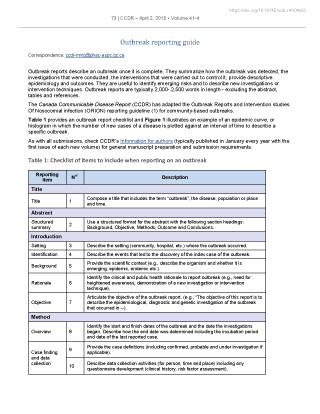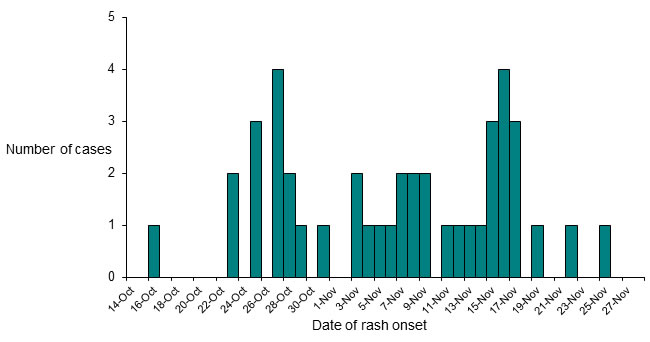Outbreak reporting guide, 2015

 Download this article as a PDF (570 KB - 3 pages)
Download this article as a PDF (570 KB - 3 pages) Published by: The Public Health Agency of Canada
Issue: Volume 41-4: Scientific writing
Date published: April 2, 2015
ISSN: 1481-8531
Submit a manuscript
About CCDR
Browse
Volume 41-4, April 2, 2015: Scientific writing
Scientific writing
Outbreak reporting guide
Correspondence
DOI
https://doi.org/10.14745/ccdr.v41i04a02
Outbreak reports describe an outbreak once it is complete. They summarize how the outbreak was detected, the investigations that were conducted, the interventions that were carried out to control it, provide descriptive epidemiology and outcomes. They are useful to identify emerging risks and to describe new investigations or intervention techniques. Outbreak reports are typically 2,000- 2,500 words in length - excluding the abstract, tables and references.
The Canada Communicable Disease Report (CCDR) has adapted the Outbreak Reports and Intervention studies Of Nosocomial infection (ORION) reporting guidelineFootnote 1 for community-based outbreaks.
Table 1 provides an outbreak report checklist and Figure 1 illustrates an example of an epidemic curve, or histogram in which the number of new cases of a disease is plotted against an interval of time to describe a specific outbreak.
As with all submissions, check CCDR's Information for authors (typically published in January every year with the first issue of each new volume) for general manuscript preparation and submission requirements.
| Reporting item | No1Table 1 footnote 1 | Description |
|---|---|---|
| Title | ||
| Title | 1 | Compose a title that includes the term “outbreak”, the disease, population or place and time. |
| Abstract | ||
| Structured summary | 2 | Use a structured format for the abstract with the following section headings: Background, Objective, Methods, Outcome and Conclusions. |
| Introduction | ||
| Setting | 3 | Describe the setting (community, hospital, etc.) where the outbreak occurred. |
| Identification | 4 | Describe the events that led to the discovery of the index case of the outbreak. |
| Background | 5 | Provide the scientific context (e.g., describe the organism and whether it is emerging, epidemic, endemic etc.). |
| Rationale | 6 | Identify the clinical and public health rationale to report outbreak (e.g., need for heightened awareness, demonstration of a new investigation or intervention technique). |
| Objective | 7 | Articulate the objective of the outbreak report. (e.g., “The objective of this report is to describe the epidemiological, diagnostic and genetic investigation of the outbreak that occurred in --). |
| Method | ||
| Overview | 8 | Identify the start and finish dates of the outbreak and the date the investigations began. Describe how the end date was determined including the incubation period and date of the last reported case. |
| Case finding and data collection | 9 | Provide the case definitions (including confirmed, probable and under investigation if applicable). |
| 10 | Describe data collection activities (for person, time and place) including any questionnaire development (clinical history, risk factor assessment). | |
| Investigations | 11 | Provide a systematic description of how the outbreak was investigated including
|
| Epidemiologic and statistical analyses | 12 | Describe any analytical methods used assess the outbreak (e.g., risk factor analysis, survival analysis, estimation of background rates). |
| 13 | Reference any complex analytical methods used (e.g., social network analysis, estimation of R0). | |
| 14 | Include any sub-group analyses, what was done to control for interactions and confounding factors and how missing data and reporting delays were addressed. | |
| Interventions | 15 | Describe the clinical and public health measures that were put in place to control the outbreak including as applicable including
|
| Results | ||
| Descriptive epidemiology | 16 | Provide an overview of what happened by person, time and place. |
| Ancillary analyses | 17 | Provide subgroup analyses and describe the assessment of interactions and confounders as indicated. |
| Complications | 18 | Identify any complications, such as hospitalizations and deaths. |
| Epidemic curve | 19 | Provide a figure showing the epidemic curve. In the title include the disease, population/place and time (year). |
| Frequency table | 20 | Include a table with demographic characteristics (e.g., age and sex) and symptom frequency, if applicable. |
| Discussion | ||
| Key results | 21 | Summarize key findings that relate to the report objective, highlighting the new or important aspects of the outbreak and their significance. |
| Comparison | 22 | Consider these findings in relation to the current literature. |
| Strengths and weaknesses | 23 | Identify strengths and weaknesses of the outbreak investigation and response. |
| Conclusion | 24 | Ensure conclusions address objective and follow from the results. |
Figure 1: Example of an epidemic curve for a measles outbreakFootnote 2

Text description: Figure 1
Figure 1: Example of an epidemic curve for a measles outbreakFootnote 2
This is a histogram showing the distribution of 42 confirmed cases in a measles outbreak that occurred in Alberta between October 16 to November 25, 2013. Cases are identified by date of rash onset. There are 13 days when a single case of measles was identified. There are 17 days when no cases were identified, and 11 days when two to four cases were identified. There are two peaks in the outbreak: four cases were reported on October 27 and on November 16, approximately one third and three-quarters of the way through the outbreak.
Page details
- Date modified: